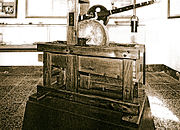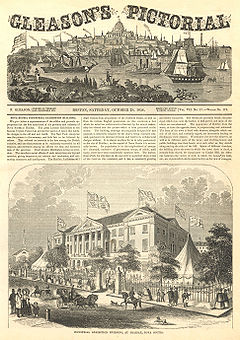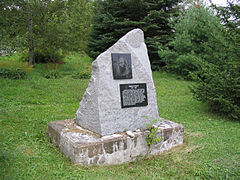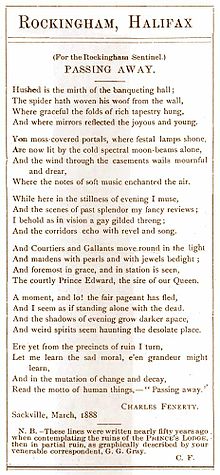- Charles Fenerty
-
Charles Fenerty 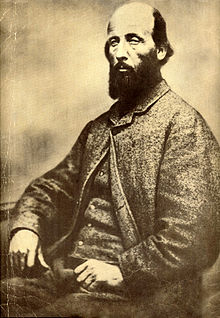
Charles Fenerty c.1870Born c.January 1821 (DOB not known)
Upper Sackville, Nova Scotia (Canada was not a united country at his birth)Died June 10, 1892
Lower Sackville, Nova Scotia, CanadaResidence Nova Scotia, Canada, and Australia (living in different regions) Nationality Nova Scotian and Canadian Occupation farmer, writer (journalist articles), lumberman, lumber mill worker, Sackville church board, Wood Measurer, Census Taker, Health Warden Known for The invention of wood pulp for the production of paper Spouse Anne Hamilton Children He had no children Awards Winner of the Nova Scotia Industrial Exhibition "Poetry Contest". The title of the poem: Betula Nigra. He also awarded for making "The Best Wood Laths in Nova Scotia".[1] Website http://www.charlesfenerty.ca http://www.charlesfenerty.com Charles Fenerty (January, 1821[2][3] – 10 June 1892), is a Canadian inventor who invented the wood pulp process for papermaking, which was first adapted into the production of newsprint.[4][5] Fenerty was also a poet (writing over 32 known poems).[6] He also did extensive traveling throughout Australia between the years 1858 to 1865 (living in the heart of the Australian gold rushes).
Contents
History of Paper (before 1844)
Main article: History of paperBefore wood pulp, paper was made from rags. Papermaking began in Egypt (see Papyrus) c.3000 B.C. In 105 AD, Ts'ai Lun[7] a Chinese inventor, invented modern papermaking using rags, cotton, and other plant fibers by pulping it. Then in the 18th century a French scientist by the name of René Antoine Ferchault de Réaumur suggested that paper could be made from trees.[8] Though he never experimented himself, his theory caught the interest of others, namely Matthias Koops. In 1800 Koops published a book on papermaking made from straw. Its outer covers were made from trees. His method wasn't like Fenerty's (pulping wood); instead he simply ground the wood and adhered it together. His book does not mention anything to do with wood pulping.[9][10]
Friedrich Gottlob Keller
Coincidentally, in around 1838 a German weaver by the name of Friedrich Gottlob Keller read Réaumur's report and got curious. Unaware of Fenerty across the ocean, he experimented for a few years and, in 1845, filed for a patent in Germany for the ground wood pulp process for making modern paper.[11][12] This was the beginning of a very large industry that exists to this day. In that same year Henry Voelter bought the patent for about five hundred dollars and started making paper. Keller did not have the funds to do it. At one point he did not have sufficient money to renew his patent. Keller died poor, but well remembered in Germany as being the first to discover the process.
Early life
As a youth, Charles worked for his father in the family lumber mills. During the winter months the Fenerty's would clear-cut the local forests for lumber (something Charles did not like). It would then be transported from neighboring lakes to Springfield Lake (where their lumber mill was located). The lumber would then be hauled into the mill and cut up. The Fenerty's would ship their lumber to the Halifax dockyards, where it was exported or used for local use (since Halifax was going through a "building boom" at the time).[13] He had two brothers (he was the youngest boy), both of whom helped with the operations. Charles was also a farmer. The Fenerty's had around 1,000 acres (4.0 km2) of farm land. They would ship most of their produce to the markets in Halifax. It was in his youth where he was inspired by both nature and poetry. His first (known) poem was titled *The Prince’s Lodge (later retitled as "Passing Away" and published in 1888). He was 17-years-old when he wrote it. It was about the decaying home (overlooking the Bedford Basin near Halifax) that was built decades prior by Prince Edward Augustus, Duke of Kent and Strathearn. The lodge was in poor condition, and was not occupied as Prince Edward return to England in August 1800.[14] He would have had passed this home every time he hauled his lumber and produce to Halifax. But he would pass the local paper mills too.
In those days paper was made from pulped rags. It was a technique used for nearly 2000 years. And suddenly demands reached their peak, while rag supplies reached its all time low. Charles was very curious of how paper was made, and often stopped at these paper mills. There was many similarities between paper mills and lumber mills; something young Fenerty saw and experimented with. Demand for paper was so high that eventually Europe starting cutting down their shipments of cotton to North America. After seeing how paper is made and comparing it to the saw mills, it is not difficult to imagine how Fenerty got the idea (since the process is very much the same: fibres are extracted from the cotton and used to make paper). And Charles knew very well that trees have fibres too (from his relationship with the naturalist Titus Smith.[15] At the age of 17 (in c.1838) he began his experiments of making paper from wood. But 1844 he had perfected the process (including bleaching the pulp to a white colour). In a letter written by a family member circa 1915 it is mentioned that Charles Fenerty had shown a crude sample of his paper to a friend named Charles Hamilton in 1840 (a relative of his future wife).
Fenerty's Invention
Charles Fenerty began experimenting with wood pulp around 1838. And in 1844 he made his discovery. On October 26, 1844 Charles Fenerty took a sample of his paper to Halifax's top newspaper, the Acadian Recorder, where he had written a letter on his newly invented paper saying:
“ Messrs. English & Blackadar, Enclosed is a small piece of PAPER, the result of an experiment I have made, in order to ascertain if that useful article might not be manufactured from WOOD. The result has proved that opinion to be correct, for- by the sample which I have sent you, Gentlemen- you will perceive the feasibility of it. The enclosed, which is as firm in its texture as white, and to all appearance as durable as the common wrapping paper made from hemp, cotton, or the ordinary materials of manufacture is ACTUALLY COMPOSED OF SPRUCE WOOD, reduced to a pulp, and subjected to the same treatment as paper is in course of being made, only with this exception, VIZ: my insufficient means of giving it the required pressure. I entertain an opinion that our common forest trees, either hard or soft wood, but more especially the fir, spruce, or poplar, on account of the fibrous quality of their wood, might easily be reduced by a chafing machine, and manufactured into paper of the finest kind. This opinion, Sirs, I think the experiment will justify, and leaving it to be prosecuted further by the scientific, or the curious.
I remain, Gentlemen, your obdt. servant,
CHARLES FENERTY.The Acadian Recorder
Halifax, N.S.
Saturday, October 26, 1844” Death and legacy
Little attention was given and even Fenerty himself never pursued the idea and he never took out a patent on his process. But it did mark the beginning to a new industry, although today most people attribute F. G. Keller as the original inventor.
Fenerty travelled to Australia then returned again to Halifax in 1865. He held several positions: Wood Measurer, Census Taker, Health Warden, Tax Collector for his community, and Overseer of the Poor. He was also very involved with the Church. Fenerty died on June 10, 1892 in his home in Upper Sackville, Nova Scotia, from a flu.
Fenerty was also a well known poet of his time, publishing more than 35 (known) poems. Some popular titles were: "Betula Nigra" (about a Black Birch tree), "Essay on Progress" (published in 1866), and "The Prince's Lodge" (about Prince Edward Augustus, Duke of Kent and Strathearn, written around 1838 and published in 1888). In October 1854, he won first prize for "Betula Nigra" at the Nova Scotia Industrial Exhibition.[17]
Pulped wood paper slowly began to be adopted by paper mills throughout Canada, the U.S., and Europe. Then to the rest of the world. Charles would live to see the very first wood pulp paper mill erected near his home town (where some claim he worked part-time in his latter years). German newspapers were the first to adopt the process, then other newspaper made the painful switch from rags to wood pulp. By the end of the 19th-century almost all newspapers in the western world were using pulp wood newsprint.
Poems by Charles Fenerty
- The Prince’s Lodge (His first known poem, written in c.1837)
- Betula Nigra (His award winning poem)[18]
- Battle of the Alma
- In Memoriam of James Montgomery
- The Relic
- Hid Treasure: Canto I
- Hid Treasure: Canto II
- Hid Treasure: Canto III
- To a Rich Miser
- The Saxon's Sentimental Journey
- The Tao-Aspiring Poet
- A Lilt of Skibbereen
- Reason and Faith
- Hymn
- The Man of God
- Farewell to Australia (1865)
- The Voyagers on Gennesaret
- Keep the Heart Young
- Essay on Progress
- The Decline of Spain
- Lex Talionis
- The Blind Lady's Request
- Early Piety
- Terra Nova
- To a Meteorite
- The Sentinel Rose
- In Memoriam
- The Wreck of the Atlantic
- Sir Provo Wallis (His last known poem, written in 1892)
- Passing On
- Eighteen Hundred and Two
- Howe
Recognition
On Canada Day in 1987, Canada Post featured Fenerty on one of a set of four stamps commemorating Canadian inventors in Communications.[19]
See also
- Acadia Paper Mill
- René Antoine Ferchault de Réaumur
- Fiber crop
- Invention in Canada
- List of Canadian poets
- List of Canadian writers
- List of people on stamps of Canada
- Lower Sackville, Nova Scotia
- Newsprint
- Paper engineering
- Pulp (paper)
- Pulpwood
- Technological and industrial history of Canada
- The Greatest Canadian Invention
- Timeline of historic inventions
- Wood pulp
Bibliography
- Acadian Recorder, Halifax Nova Scotia, 1817-1892.
- Burger, Peter. Charles Fenerty and his Paper Invention. Toronto: Peter Burger, 2007. ISBN 978-0-9783318-1-8
- Canadian Encyclopedia, The. Toronto: McClelland & Stewart Inc., 2000.
- Carruthers, George. Paper in the Making. Toronto: The Garden City Press Co-Operative, 1947.
- Crowley, David, Paul Heyer. Communication in History: Technology, Culture, Society, 5th ed. Boston: Pearson Allyn & Bacon, 2007.
- Dictionary of Canadian Biography. Vol. I – XII. Toronto: University of Toronto Press, 1990.
- Encyclopedia Canadiana. 10 vols. Toronto: Grolier of Canada Ltd., 1977.
- Fenerty, Charles. Betula Nigra. Halifax: W. Cunnabell, 1855.
- Fenerty, Charles. Essay on Progress. Halifax: James Bowes & Sons, 1866.
- Fenerty, Charles. (Manuscript) "Hid Treasure" or the Labours of a Deacon–and other poems. Halifax: MS Pp 81, n/p, n/d (ca.1888). (Dalhousie University call Number: MS-2-158)
- Fergusson, Dr. Charles Bruce. Charles Fenerty: The Life and Achievement of a Native of Sackville, Halifax County, N.S. Halifax: William Macnab & Son, 1955.
- Halifax Herald, The, Halifax, Nova Scotia, 1840-1892.
- Harvey, Robert Paton. Historic Sackville. Halifax: Nimbus Publishing Ltd, 2002.
- Hunter, Dard. Papermaking: The History and Technique of an Ancient Craft. New York: Dover Publications, Inc. 1978.
- Knott, Leonard L. The Children's Book about Pulp and Paper. Montreal: Editorial Associates, 1949.
- Koops, Matthias. Historical account of the substances which have been used to describe events, and to convey ideas, from the earliest date, to the invention of paper. London: Printed by T. Burton, 1800.
- MacBeath, George. Great Maritime Achievers in Science and Technology. Fredericton, NB: Goose Lane Editions, 2005.
- MacFarlane, William Godsoe. "Fenerty, Charles". New Brunswick Bibliography: The Books and Writers of the Province. St. John, N.B., 1895: 30. (Available at the University of Toronto, CIHM no.: 09418).
- Marble, Allen Everett. Nova Scotians at Home and Abroad. Windsor, NS: Lancelot Press Ltd, 1986.
- Morgan, Henry J. "Fenerty, Charles". Bibliotheca Canadensis. Ottawa: G.E. Desbarats. 1867.
- Mullane, George. Footprints Around and About Bedford Basin. Halifax: (Reprints from the Acadian Recorder), n/p, ca.1914. (CIHM no. 78665 U of T) ISBN 0-665-78665-4
- NovaScotian, The, Halifax, Nova Scotia, 1830-1880.
- Nova Scotia Archives and Records Management (NSARM).
- Pönicke, Herbert. "Keller, Friedrich Gottlob". Neue Deutsche Biographie. Berlin: Duncker & Humblot, 1977.
- Punch, Terrence Michael. Some Native Sons of Erin in Nova Scotia. Halifax: Petheric Press, 1980.
- Punch, Terrence M. "Fenerty, Charles". Dictionary of Canadian Biography. (Vol. XII. 1891 to 1900). Toronto: University of Toronto Press, 1990: 311.
- Punch, Terrence M. Nova Scotia Vital Statistics from Newspaper, 1818–1822. Halifax: Genealogical Association of the Royal Nova Scotia Historical Society, Publication No. 1, 1978.
- Raddall, Thomas H. Halifax – Warden of the North. Toronto: McClelland and Stewart Ltd, 1977.
- Schlieder, Wolfgang. Der Erfinder des Holzschliffs Friedrich Gottlob Keller. Leipzig, Germany: Veb Fachbuchverlag Leipzig, 1977.
- Sittauer, Hans L. Friedrich Gottlob Keller. Leipzig: BSB B.G. Teubner Verlagsgesellschaft, 1982.
- Tennant, Robert D. Jr. Millview: From Winter Cove to Salt Hill. Nova Scotia: n/p, n/d, (held at the Fultz Museum, Sackville, NS).
- Walther Killy and Rudolf Vierhaus. "Keller, Friedrich Gottlob". Deutsche Biographische Enzyklopädie. München: Die Deutsche Bibliothek, 1997.
- Watters, Reginald Eyre. A Check List of Canadian Literature and Background Materials: 1628–1950. Toronto: University of Toronto Press, 1959.
References
- ^ Burger, Peter. Charles Fenerty and his Paper Invention. Toronto: Peter Burger, 2007. ISBN 978-0-9783318-1-8 pp.44-45
- ^ Burger, Peter. Charles Fenerty and his Paper Invention. Toronto: Peter Burger, 2007. ISBN 978-0-9783318-1-8 pp.14-15
- ^ His date of birth still remains unknown. Though his tombstone says 1821, there is enough evidence to suggest that his birth year was 1820 (see: Charles Fenerty and his Paper Invention by Burger, Peter)
- ^ Burger, Peter. Charles Fenerty and his Paper Invention. Toronto: Peter Burger, 2007. ISBN 978-0-9783318-1-8 (a biography on the life and times of Charles Fenerty, including his paper invention and his poetry)
- ^ Charles Fenerty was the Canadian inventor of the pulp wood process, but at the very same time in Germany a weaver and machinist by the name of F. G. Keller had invented the process also (he is often referred to as the sole inventor because he took out a patent on the process).
- ^ Burger, Peter. Charles Fenerty and his Paper Invention. Toronto: Peter Burger, 2007. ISBN 978-0-9783318-1-8 pp.89-169
- ^ Burger, Peter. Charles Fenerty and his Paper Invention. Toronto: Peter Burger, 2007. ISBN 978-0-9783318-1-8 pp.28, 30, 82
- ^ Burger, Peter. Charles Fenerty and his Paper Invention. Toronto: Peter Burger, 2007. ISBN 978-0-9783318-1-8 pp.30-33
- ^ Burger, Peter. Charles Fenerty and his Paper Invention. Toronto: Peter Burger, 2007. ISBN 978-0-9783318-1-8 pp.30-32
- ^ Some books mentioning Koops' discovery will say or suggest that his book was made partially from wood pulp, but this is not the case. Koops clearly outlines his method for making paper from straw and trees. The closest he got was taking wood shavings and adhering them and pressing them together to make a sheet of paper.
- ^ Burger, Peter. Charles Fenerty and his Paper Invention. Toronto: Peter Burger, 2007. ISBN 978-0-9783318-1-8 28-34.
- ^ The biography Charles Fenerty and his Paper Invention by Peter Burger has the most detailed account in English on his life and invention. Both Fenerty and Keller are the two pioneers in the invention of wood pulp paper.
- ^ Burger, Peter. Charles Fenerty and his Paper Invention. Toronto: Peter Burger, 2007. ISBN 978-0-9783318-1-8 pp.8-9.
- ^ Burger, Peter. Charles Fenerty and his Paper Invention. Toronto: Peter Burger, 2007. ISBN 978-0-9783318-1-8 pp.11-13
- ^ Burger, Peter. Charles Fenerty and his Paper Invention. Toronto: Peter Burger, 2007. ISBN 978-0-9783318-1-8
- ^ Burger, Peter. Charles Fenerty and his Paper Invention. Toronto: Peter Burger, 2007. ISBN 978-0-9783318-1-8 pp.32 (The biography has a photo of the original letter.)
- ^ Burger, Peter. Charles Fenerty and his Paper Invention. Toronto: Peter Burger, 2007. ISBN 978-0-9783318-1-8 pp.40-45
- ^ Fenerty won the 1854 Nova Scotia Industrial Exhibition Award for best poem of a Canadian topic.)
- ^ Charles Fenerty stamp, issued by Canada Post
External links
Categories:- Papermakers
- 1821 births
- 1892 deaths
- Canadian inventors
- People from Sackville, Nova Scotia
- Pre-Confederation Nova Scotia people
- Canadian poets
Wikimedia Foundation. 2010.

